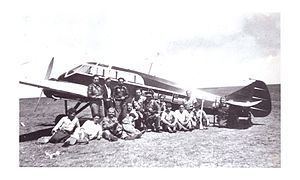The General Aircraft Monospar ST-25 was a British 1930s light twin-engined utility aircraft.
Design and development
The Monospar ST-25 was a low-wing cantilever monoplane with a fabric-covered metal structure. The monospar name came from the use of a single spar in the wing structure, that had been developed by H J Stieger. The cabin was enclosed with five seats. It was based on the GAL Monospar ST-10, with the addition of a folding seat for a fifth passenger, extra side windows, and the addition of a radio receiver. On 19 June 1935, the prototype (G-ADIV) made its first flight at Hanworth Air Park. It was designated Monospar ST-25 Jubilee, to honour the 25th anniversary of the reign of King George V.
The last flying Monospar ST-25 (ZK-AFF), of Piet Van Asch, the owner of New Zealand Aerial Mapping Ltd, was lost in 1986 in a hangar fire.The last surviving Monospar ST-25 (OY-DAZ), an ST-25 Ambulance, was fully restored during 1989-1999, and is now displayed in Egeskov Veteranmuseum at Egeskov Castle, Denmark.Monospar ST-25 Jubilee(1935-1936) Single fin and rudder. 30 built.
Monospar ST-25 De LuxeOne Monospar ST-25 Jubilee with a large single fin and two
Niagara II engines, later converted to the prototype Monospar ST-25 Universal, with twin fins.
Monospar ST-25 AmbulanceVariants of both Monospar ST-25 Jubilee and ST-25 Universal, with a large door on the starboard side to allow a stretcher to be loaded.
Monospar ST-25 Universal(1936-1939) Twin fin and twin rudder. 29 built, including the conversion of the De Luxe.
Monospar ST-25 FreighterA variant of the Monospar ST-25 Universal, with a large freight door but without the passenger seating.
GAL.26One modified Monospar ST-25 Jubilee, fitted with two
Cirrus Minor I engines in 1936.
GAL.41One experimental aircraft based on the Monospar ST-25 Universal. A new fuselage was built containing a pressurized section with two seats. Its purpose was to test possible pressurization systems for a proposed airliner, the GAL.40. The GAL.41 flew for the first time 11 May 1939, and was grounded in 1941.
AustraliaAdelaide Airways CanadaEastern Canada Air Lines (five ST-25 Freighters, delivered in 1936) Denmark FranceArmée de l'Air (2 ST-25 in Indochine (Vietnam) in November 1945) NetherlandsVan Melle's Confectionery Works, Breskens (one Jubilee, PH-IPM "Dubbele Arend', delivered in 1935) New ZealandNew Zealand Aerial MappingRoyal New Zealand Air Force RomaniaRoyal Romanian Air Force SpainSpanish Republican Air Force SpainSpanish Air Force TurkeyGeneral Command of Mapping (Turkey)Turkish Government (two ST-25 Freighters for parachute training delivered in 1937) United KingdomCrilly AirwaysRoyal Aircraft Establishment (two Jubilees used for radio development)Royal Air Force (impressed civil aircraft used during the second world war)Data from Jackson, 1973
General characteristics
Crew: oneLength: 26 ft 4 in (8.03 m)Wingspan: 40 ft 2 in (12.24 m)Height: 7 ft 10 in (2.39 m)Wing area: 217 sq ft (20.2 m2)Empty weight: 1,680 lb (762 kg)Gross weight: 2,875 lb (1,304 kg)Powerplant: 2 × Pobjoy Niagara II 7-cyl. air-cooled radial piston engine, 90 hp (67 kW) eachPerformance
Maximum speed: 142 mph (229 km/h; 123 kn)Range: 585 mi (508 nmi; 941 km)Service ceiling: 16,000 ft (4,900 m)Rate of climb: 800 ft/min (4.1 m/s)
